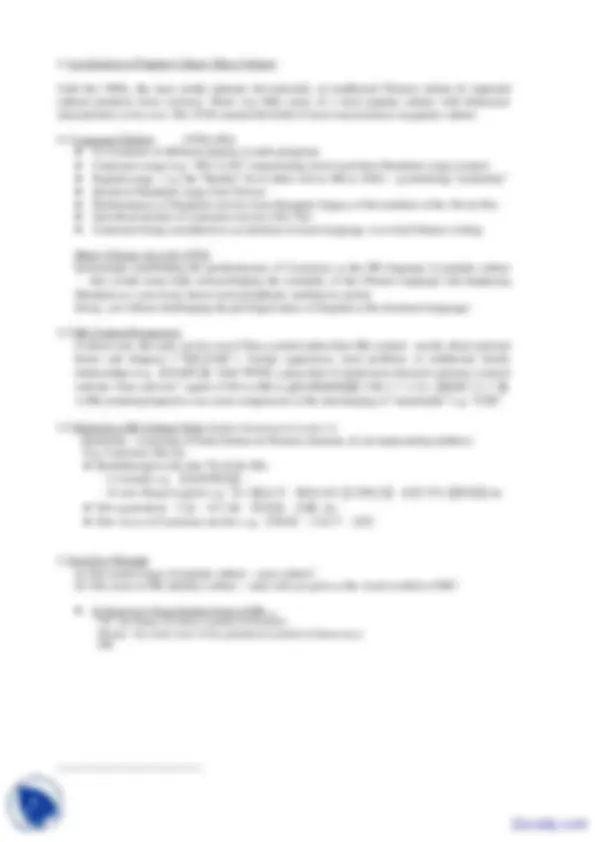



Study with the several resources on Docsity

Earn points by helping other students or get them with a premium plan


Prepare for your exams
Study with the several resources on Docsity

Earn points to download
Earn points by helping other students or get them with a premium plan
Community
Ask the community for help and clear up your study doubts
Discover the best universities in your country according to Docsity users
Free resources
Download our free guides on studying techniques, anxiety management strategies, and thesis advice from Docsity tutors
It is the Lecture Notes of Hong Kong Culture which includes Theoretical Position, Rethinking Colonialism Nationalism, Themselves As Sojourners, Immigration Policy Making, Republic of China, Systematic Ideological Discourse etc. Key important points are: Identity, Republic of China, Socio Economic Differences, Capitalism Versus Communism, Demographic, Significant Events, Localization of Culture, Growth of Popular Culture, Pearl River Delta, Competing Ideologies
Typology: Study notes
1 / 2

This page cannot be seen from the preview
Don't miss anything!


L2: HK Identity
1. Historical Emergence of HK Identity after the 1950s – An Overview
The Context: Changes after the 1950s: Birth of People’s Republic of China (PRC), as led by the communist party, in 1949 – giving rise to increasing ideological, political & socio-economic differences from HK {Global context: the Cold War ideology of “liberalism/ capitalism versus communism”}
Introduction of border control in HK in the early 1950s, followed by the first distribution of ID cards, because of large influx of Chinese immigrants from the mainland [later lectures]
Internal changes within the society – demographic (population growth; changing proportion between local-born and mainland-born populations), economic, social, political & cultural changes since the 1960s [Today’s Lecture: cultural development]
Significant events: the riots in 1966 and 1967 were the most significant events – changing roles & policies of the government after the riots, e.g. civic campaign, provision of public housing [later lectures]. [For reference, you may read #4 Turner & Ngan eds. (1995), pp 80-83, 13-34.]
II. Cultural Formation: Growth of Popular Culture & Localization of Culture (1950s-70s)
Government policy on cultural development before & during the 1950s: laissez faire
Until early 20thC, popular leisure was mainly in the form of traditional Chinese folk culture while the mass media industry was at a budding stage. The 1950s & 1960s marked a new development when the influx of Chinese immigrants brought about (a) inflow of capital - material & cultural - & (b) market potentials. (A non-cable TV broadcasting was established in 1967.) The 1970s witnessed a great expansion of local mass culture in TV series, popular songs, movies & press etc.
Until the 1960s, the mass media industry fed primarily on traditional Chinese culture & imported cultural products from overseas. There was little sense of a local popular culture with distinctive characteristics of its own. The 1970s marked the birth of local consciousness in popular culture.
4.1 Language/ Dialect [1940s-60s] Co-existence of different dialects in radio programs Cantonese songs (e.g. “賭仔自嘆”) representing lower taste than Mandarin songs [center] English songs – e.g. the “Beatles” fever (their visit to HK in 1964) – symbolizing “modernity” Inroad of Mandarin songs from Taiwan Predominance of Mandarin movies from Shanghai (legacy of the tradition of the 30s & 40s) Growth & decline of Cantonese movies (50s-70s) Cantonese being considered as an informal or lesser language, or as bad Chinese writing
Major Change since the 1970s Increasingly establishing the predominance of Cantonese as the HK language in popular culture ― this would mean both acknowledging the centrality of the Chinese language and displacing Mandarin as a non-local, hence more peripheral, medium in society (Irony: yet without challenging the privileged status of English as the dominant language)
4.2 HK-Centred Perspective Content-wise, the early movies were China-centred rather than HK-centred - mostly about national honor and disgrace (“電影救國”), foreign aggression, rural problem, or traditional family relationships (e.g. 【家春秋】). After WWII, a great deal of media texts showed a primary concern with the “here and now” aspect of life in HK (e.g.【危樓春曉】、【可憐天下父母心】、【獅子山下】). A HK-centred perspective was most conspicuous in the stereotyping of “mainlander” e.g. “阿燦”.
4.3 Distinctive HK Culture/ Style ( further discussion in Lecture 3) [Hybridity - consisting of both Chinese & Western elements, & yet representing neither.] E.g. Cantonese Movies Breakthrough in the late 70s & the 80s:
In Search of a Visual Symbol (Icon) of HK …